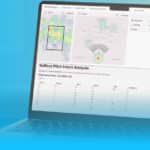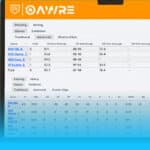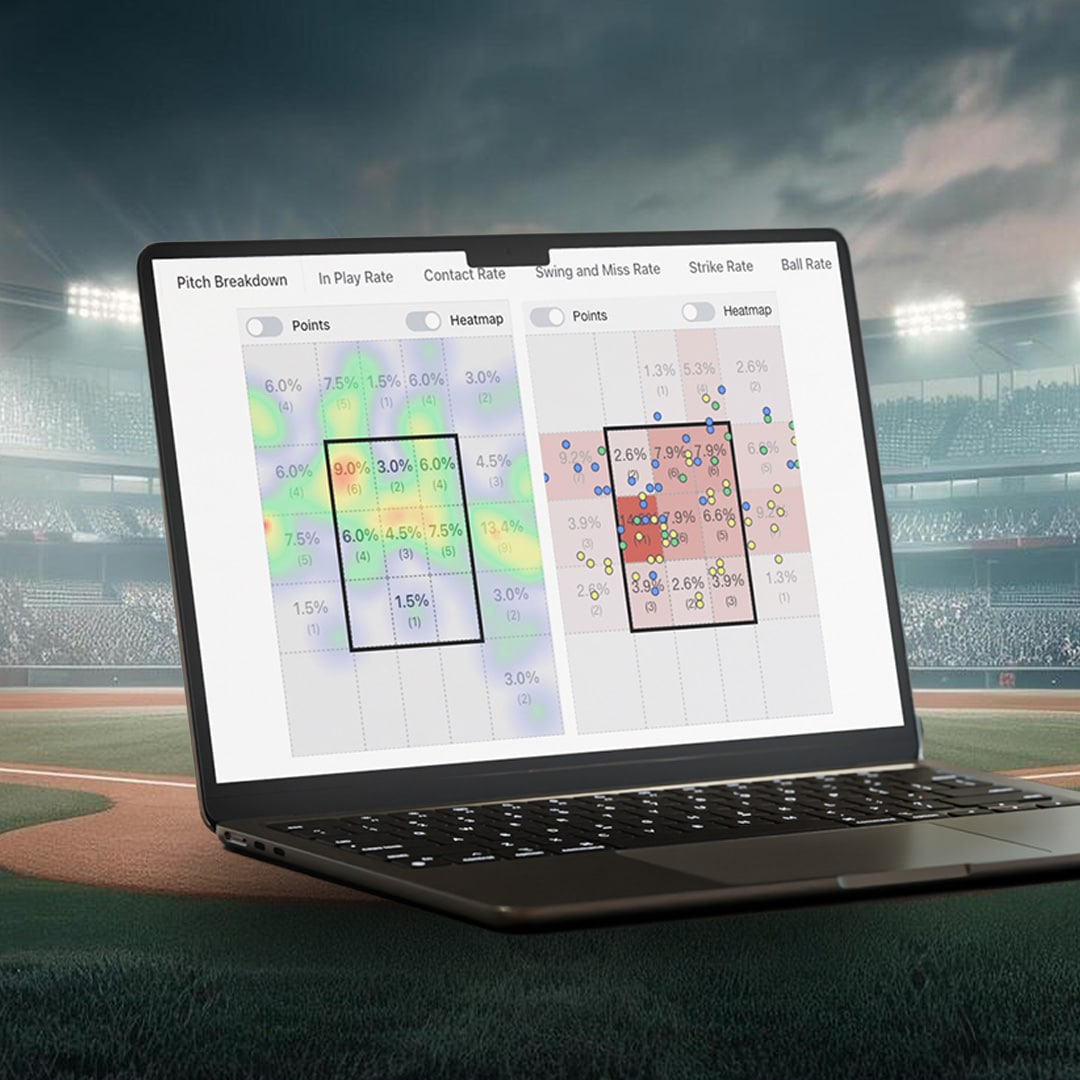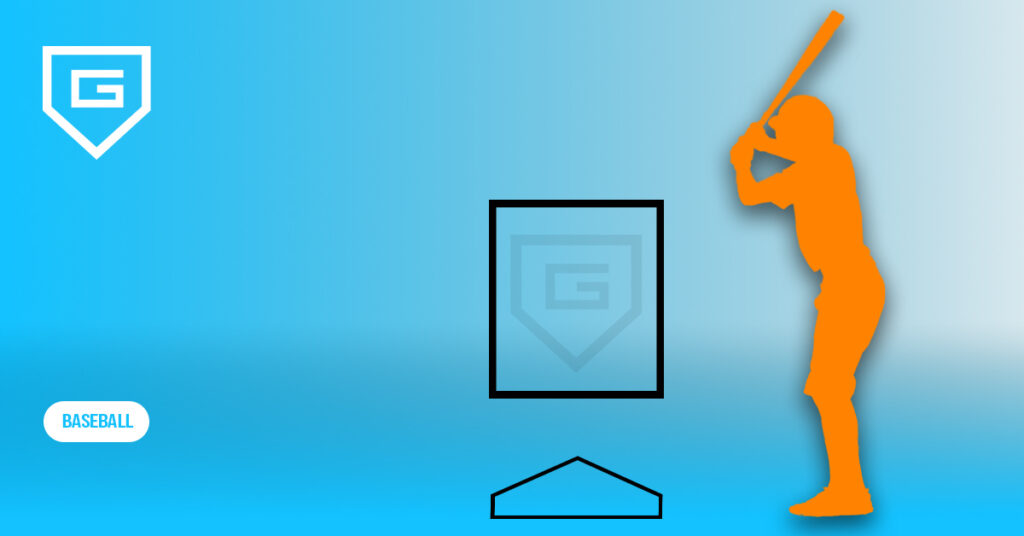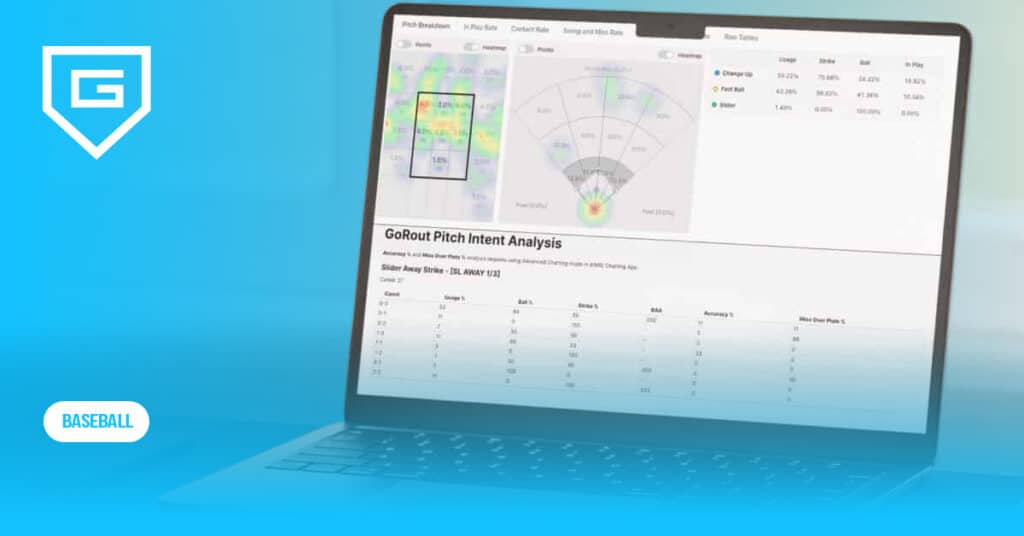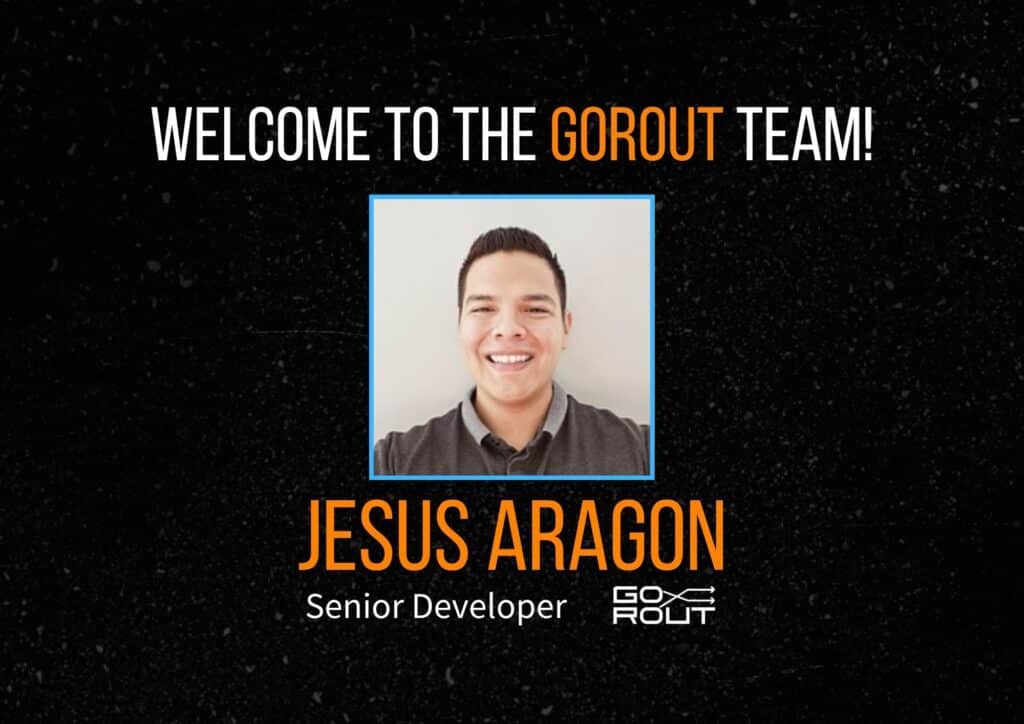Baseball Strike Zone: A Complete Guide & History
Reading Time: 28 minutes
Reading Time: 28 minutes
The baseball strike zone dictates every single pitch in a game. The area over home plate a pitcher aims for and what determines whether a pitch is a strike or ball, the strike zone is an essential component of baseball rules and gameplay.
If it didn’t exist, hitters could wait as long as they wanted without swinging until they received their perfect pitch. In a sense, the strike zone defines a “hittable pitch” that batters should swing at.
It also serves as both a reward and penalty system. Batters are penalized for not swinging at pitches in the zone, and pitchers are penalized for throwing pitches outside the zone that batters don’t chase. As a pitcher, if you attack the zone with consistent command, you’re rewarded with strike calls. Batters are rewarded for not chasing pitches outside of the zone with balls and walks.
Each league has a different definition of the strike zone, with major governing bodies determining the dimensions for each respective level of play. The strike zone has a long, ever-changing history from the early days of baseball to today’s modern rendition.
Automated electronic strike zones exist and have been tested in various leagues, though the human element of an umpire remains. With the rapid pace of technological advancement, the future of the strike zone will incorporate an automated zone in some sense. Technology also provides coaches with baseball analytics and insights about the strike zone that help inform their strategy.
Intro to the Baseball Strike Zone
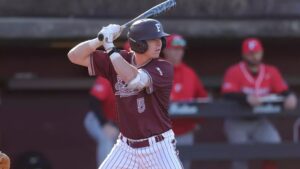
This guide will cover everything you need to know about the strike zone in baseball. Continue reading to learn:
- What the baseball strike zone is
- Strike zone dimensions by league
- The definition of a strike in baseball
- A history of the strike zone
- The umpire’s role
- Impact of the zone on gameplay
- How to use the strike zone to your advantage
- Technology’s role in redefining the zone
What Is The Baseball Strike Zone?
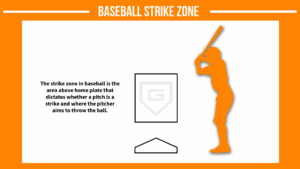
The strike zone in baseball is the area above home plate that dictates whether a pitch is a strike and where the pitcher aims to throw the ball. It’s set by the width of home plate (which is 17 inches wide) and a vertical range from the batter’s midpoint to their knee, though the precise definition and dimensions vary by league.
To get a strike call, some part of the ball has to pass through the aforementioned area. In theory, the strike zone indicates the space where the batter can reasonably make solid contact with the ball. If a pitch goes through the zone and the batter doesn’t swing, they’re presumably passing up a hittable pitch and penalized one strike for doing so.
Baseball Strike Zone Dimensions
There is no “single source of truth” when it comes to the strike zone’s dimensions in baseball. The specific measurements are determined on a league-by-league basis and subject to the umpire’s interpretation. Width is the only technical measurement consistent across all leagues, at 17 inches wide, because that’s the width of a standard home plate.
Across the board, the strike zone is determined by the batter’s normal stance as they prepare to swing at a pitched ball. Though a subjective definition, this prevents players from crouching in an unnatural stance to try and “shrink” the strike zone and draw more balls.
Most leagues set a defined, objective strike zone but each ump may stretch or shrink the zone intentionally or unintentionally.
The four main variations of strike zone dimensions in baseball are:
- Little League [Youth Baseball]
- National Federation of State High School Associations (NFHS) [High School Baseball]
- National Collegiate Athletic Association (NCAA) [College Baseball]
- Major League Baseball (MLB) & Minor League Baseball (MiLB) [Professional Baseball]
Little League [Youth Baseball] Strike Zone
The definition of Little League’s strike zone is the “space over home plate which is between the batter’s armpits and the top of the knees when the batter assumes a natural stance.” Little League emphasizes “the strike zone will always remain over home plate” and how it’s important to refrain from adjusting the zone if a batter crowds the plate or stands further back.
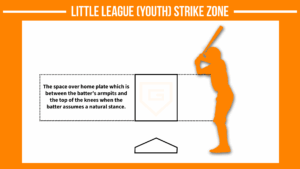
Because youth baseball is more about having fun and learning than competition, Little League encourages umpires to call “borderline” pitches strikes so batters will be more aggressive and swing at anything close. Youth travel baseball is more competitive, and umpires may adjust their mentality to fit the skill and competition level.
National Federation of State High School Associations (NFHS) [High School Baseball] Strike Zone
The strike zone in high school baseball is defined by the NFHS as “the space over home plate” where “the top of which is halfway between the batter’s shoulders and the waistline, and the bottom being the knee.”
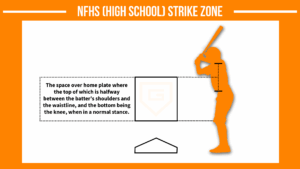
As with all leagues, the height of the zone is determined by the batter’s normal stance.
National Collegiate Athletic Association (NCAA) [College Baseball] Strike Zone
College baseball’s strike zone, as defined by the NCAA, is nearly identical to high school. In college, the strike zone is “the area over home plate from the bottom of the kneecaps to the midpoint between the top of the shoulders and the top of the uniform pants.”
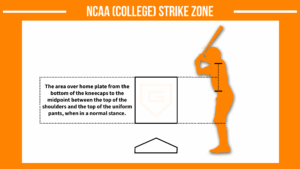
Again, the college strike zone is determined by the batter’s stance as they’re prepared to swing at a pitched ball. The NCAA’s definition is slightly more specific than high school, defining “the bottom of the kneecaps” as the bottom of the zone where the NFHS uses “the knee” in general.
Major League Baseball (MLB) and Minor League Baseball (MiLB) [Professional Baseball] Strike Zone
Major League Baseball (MLB), the world’s premier professional baseball league, defines the strike zone as “the area over home plate from the midpoint between a batter’s shoulders and the top of the uniform pants and a point just below the kneecap”. As with all of the previous leagues, the MLB judges the strike zone by the batter “in his stance and prepared to swing at a pitched ball”.
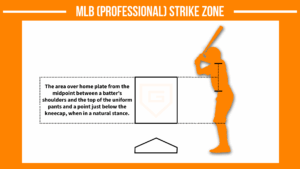
Minor League Baseball (MiLB), which sources a farm system of lower-level professional teams associated with each MLB organization, uses the same defined strike zone as the show. Different levels of MiLB have tested modern, mathematically defined automated ball-strike (ABS) strike zones.
What Is A Strike In Baseball?
A strike is a penalty against an offensive player, referred to as a batter or hitter, in baseball. The batter is called out and retired from play when they accumulate three strikes, ending their at bat.
There are several ways a strike is called, including any pitch where:
- Part of the ball passes through the strike zone and the batter doesn’t swing
- The batter swings and misses completely
- The batter makes minimal contact with the ball, referred to as a foul tip, and the catcher catches it
- The batter makes contact with the ball into foul territory on the ground
- The batter makes contact with the ball in foul territory in the air and no fielder catches it
- The batter makes contact with the ball to an area out of play (ex. Hitting a foul ball into the stands)
- The batter tries to bunt and either misses or makes contact into foul territory without any fielder making a play
- The ball hits a batter’s body part while they swing (as long as they don’t check their swing)
- The ball hits a batter’s body part located inside the strike zone (ex. a player leans their body into the strike zone trying to draw a hit-by-pitch)
- The batter takes too long to step into the batters box
History of the Strike Zone in Baseball
There’s an extensive history of the strike zone, dating back to the days before professional baseball. Between 1858 and today, the strike zone has undergone many changes, updates, alterations, and redefinitions. In the sections below, we provide an overview of the baseball strike zone’s history.
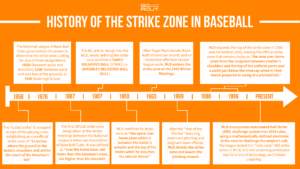
1858-1871: Conception of the strike zone
As hard as it may be to believe, the strike zone – and the idea of a called strike – wasn’t invented until 1858. Prior to that there were no called strikes and batters could wait, with no penalty, for their perfect pitch.
In 1858, Daniel “Doc” Adams of the Knickerbocker Club proposed the “called strike” in New York at the First Base Ball Convention. It was accepted as part of the playing rules and, subsequently, the strike zone was created.
The National Association of (Amateur) Base Ball Players official rules of 1858 incorporated a rule for called strikes:
- Section 37: Calling Strikes. Should a striker stand at the bat without striking at good balls repeatedly pitched to him, for the purpose of delaying the game, or of giving advantage to a player, the umpire, after warning him, shall call one strike, and if he persists in such action, two, and three strikes. When three strikes are called, he shall be subject to the same rules as if he had struck at the three balls.
Although the game incorporated called strikes, the playing rules didn’t specify or define the strike zone at that time. The strike zone was generally accepted as 12 inches above the ground to the batters shoulders and within fair reach of the Batsman’s bat.
1871-1886: Batters determine the strike zone
1871 – National Association of Professional Base-Ball Clubs
Yes, you read that correctly. Batters determined the strike zone. Starting in 1871, with the National Association of Professional Base-Ball Clubs established as the first professional baseball league, batters were given the power to determine where the pitcher would throw the ball.
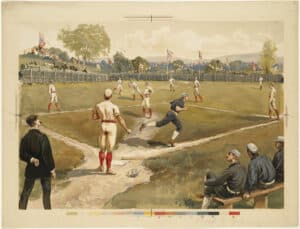
Source: Boston Public Library Flickr
They could set the zone as one of two areas:
- “Low ball”: Required to pass between the knee and the waist of the batter, and over the plate
- “High ball”: Required to pass between the waist and the shoulders of the batter, and over the plate
If the batter didn’t call for a specific “ball”, the umpire could call a strike on pitches that passed between the knees and shoulders of the batter, and over home plate.
1876 – National League of Base Ball Clubs
In 1876, the National League of Base Ball Clubs formed as a professional organization from which Major League Baseball (MLB) would grow out of. This primitive iteration of the MLB followed a similar process for determining the strike zone.
It used three designations for the batter to call:
- High: Pitches over the plate between the batter’s waist and shoulder
- Low: Pitches over the plate between the batter’s waist and at least one foot from the ground
- Fair: Pitches over the plate between the batter’s shoulders and at least one foot from the ground
1887: The first official strike zone designation
At the 1886 winter meetings (which determined the rules for the forthcoming 1887 season), the National League of Baseball Clubs – and counterpart, the American Association of Baseball Clubs – ended the practice of the batter calling for pitch location. Though they were separate organizations, they began using the same rules to dictate regulations of play.
In place of batters setting the area, the rules for 1887 designated the first official strike zone as “over the home base, not lower than the batsman’s knee, nor higher than his shoulder.”
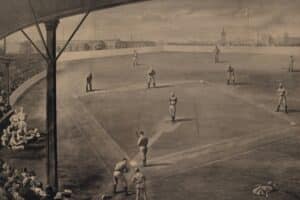
Source: Boston Public Library on Unsplash
1888-1906: Foul balls as strikes
Though “an obvious attempt to make a foul hit” was defined as a strike in 1887, several updates to the rules accounting for foul balls as strikes occurred between 1888 and 1906.
- 1894: Any foul hit while attempting a bunt hit, other than a foul tip, that falls or rolls upon foul ground between home base and first or third bases is called a strike
- 1899: A foul tip by the batter, caught by the catcher while standing within the lines of his position, is a strike
- 1901: A foul hit ball not caught on the fly is a strike unless two strikes have already been called
1907-1949: Major League Baseball redefines the strike zone
After the American Association merged with the National League (NL), the American League (AL) formed in 1901. The NL and AL signed a National Agreement in 1903, establishing the MLB as it’s known today.
Several years later, in 1907, the MLB newly defined the strike zone with designations for strikes (referred to as a “fairly delivered ball”) and balls (referred to as an “unfairly delivered ball”). The 1907 definition stated:
- A fairly delivered ball is a ball thrown to the bat by the pitcher while standing in his position and facing the batsman that passes over any portion of the home base, before touching the ground, not lower than the batsman’s knee, nor higher than his shoulder. For every such fairly delivered ball the umpire shall call one strike.
- An unfairly delivered ball is a ball delivered to the bat by the pitcher while standing in his position and facing the batsman that does not pass over any portion of the home base between the batsman’s shoulder and knees, or that touches the ground before passing home base, unless struck at by the batsman. For every unfairly delivered ball the umpire shall call one ball.
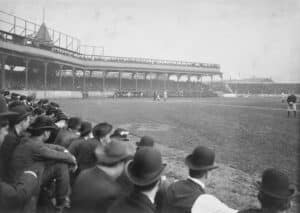
Source: Boston Public Library on Unsplash
1950-1962: A modernized strike zone and redefinition of strike
1950 – MLB strike zone definition
Between 1907 and 1950, the strike zone remained relatively unchanged. In 1950, the MLB updated its definition of the strike zone to a modern version that set the foundation for how it exists today.
The updated 1950 MLB strike zone was defined as “the space over home plate which is between the batter’s armpits and the top of his knees when he assumes his natural stance.”
More specific verbiage, with “top of” the knees establishing the bottom boundary and lowering the top of the zone to the armpits, shrunk the area from its previous definition. The 1907 strike zone, generally defined as a bottom boundary of the knee and a top boundary of the shoulders, left more room for interpretation. What part of the knee? Where does the shoulder begin or end? This 1950 update aimed to resolve those questions up for interpretation.
1957 – Redefining a strike
The aforementioned 1907 strike zone served as both the definition of a strike zone and of what a “strike” means (though they used the term “fairly delivered ball”). When the MLB updated the strike zone in 1950, the definition of a strike wasn’t far behind.
In 1957, the MLB redefined a strike as “a legal pitch when so called by the umpire which (a) is struck at by the batter and is missed; (b) enters the Strike Zone in flight and is not struck at; (c) is fouled by the batter when he has less than two strikes at it; (d) is bunted foul; (e) touches the batter as he strikes at it; (f) touches the batter in flight in the Strike Zone; or (g) becomes a foul tip.”
That set the standard of a strike relatively close to how it’s defined today.
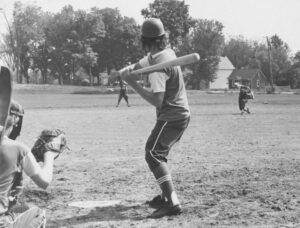
Source: The Deseronto Archives on Unsplash
1963-1987: Subtle updates
The time period between 1963 and 1987 saw two subtle updates to the strike zone. One expanded the zone in 1963, only for the other to retract it in 1969.
1963 – Expanding the zone
After Roger Maris broke Babe Ruth’s single-season home run record in 1961, among a string of impressive offensive seasons league-wide, the owners felt that run scoring became too easy. In response, they widened the strike zone at the 1963 winter meetings.
The updated 1963 MLB strike zone was defined as “that space over home plate which is between the top of the batter’s shoulders and his knees when he assumes his natural stance. The umpire shall determine the Strike Zone according to the batter’s usual stance when he swings at a pitch.”
This update expanded the top of the zone from the armpits to the top of the shoulder, and the bottom of the zone from the top of the knees to “the knees” in general. It also added that the umpire should use the batter’s normal stance when swinging to determine the zone for each player.
1969 – Retracting the zone
In 1969, the MLB backtracked on its previous decision. In response to a year of dominant pitching and stagnant team offense in 1968, coined “Year of the Pitcher”, the league made multiple adjustments during the winter meetings.
The 1969 rule changes included:
- Shrinking the strike zone
- Lowering the pitching mound from 15 inches to 10
- More aggressive monitoring for doctored baseballs
In retracting the previously expanded area, the 1969 MLB strike zone was defined as “that space over home plate which is between the batter’s armpits and the top of his knees when he assumes a natural stance. The umpire shall determine the Strike Zone according to the batter’s usual stance when he swings at a pitch.”
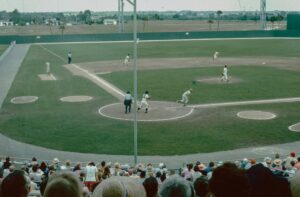
Source: Annie Spratt on Unsplash
Nearly identical to the 1950 strike zone, the 1969 definition remained true through the entire 1970s and deep into the 1980s.
1988-1995: Defining a new top boundary
The MLB updated the strike zone dimensions in 1988, creating a new definition for the top boundary.
1988’s updated MLB strike zone was defined as “that area over home plate the upper limit of which is a horizontal line at the midpoint between the top of the shoulders and the top of the uniform pants, and the lower level is a line at the top of the knees. The Strike Zone shall be determined from the batter’s stance as the batter is prepared to swing at a pitched ball.”
Determining the upper height called as a point between the top of the shoulders and top of the pants shrunk the zone furthermore. It was lowered from the armpits to a point that can be generalized as “around the letters of the uniform”, but is below the armpits, subject to the umpire’s interpretation, and may vary by player.
The league’s reasoning for a smaller strike zone at the 1987 winter meetings (determining rule changes for 1988) was to increase scoring. That updated definition set the upper limit of the MLB strike zone as it exists today.
1996-Present:
The MLB moved the lower boundary in 1996, expanding the zone once more. In an effort to speed up games, the redefined lower end of the 1996 MLB strike zone was moved from the top of the knees to the bottom of the knees, with the bottom of the knee defined as a point just below the kneecap.
The 1996 version remains the official MLB strike zone dimensions today. NCAA and NFHS definitions use similar terminology to define theirs. Little League’s strike zone more closely resembles the 1969 MLB definition, between the armpits and top of the knees.
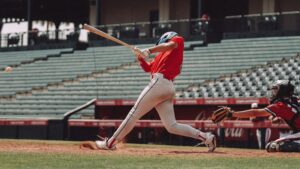
Source: Josh Hemsley on Unsplash
Footnote: 2024 ABS Strike Zone Testing in MiLB
In 2024, two leagues within MiLB defined different strike zone dimensions using pre-season body measurements to assess the height of each player:
- Triple A set the top of the strike zone as 53.5% of the batter’s height and the bottom as 27%, with a standard 17-inch width.
- The Florida State League (FSL) used Hawk-Eye visual tracking to set the bottom of the zone as the height of a hitter’s back knee and the top as the midpoint of a batter’s hips. They also expanded the width to 20 inches.
While these aren’t officially established in the rules, they indicate a future where the strike zone’s definition uses advanced technology and specific, objective measurements.
The Umpire’s Role in Determining the Strike Zone
Umpires face the ultimate challenge officiating baseball games. One of their core responsibilities is calling balls and strikes. To determine if a pitch is a ball or strike, umpires rely on the previously mentioned definitions and dimensions of the strike zone.
The subjective nature of all definitions, regardless of league, places an important challenge on the umpire to interpret them, and each respective umpire’s tendencies or bias inherently determines their strike zone.
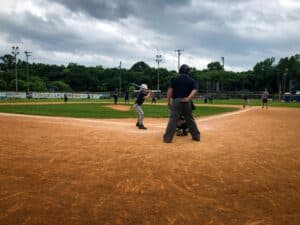
Interpreting Subjective Definitions
In all four notable levels of play (youth, high school, college, and professional), the official strike zone is set by a batter’s normal stance when preparing to swing. That’s inherently subjective by nature. There is no technical definition for “normal stance”, leaving the umpire in charge of determining what a “normal stance” means for each batter.
Umpires have to maintain a consistent strike zone no matter where the batter stands in the box. When a batter crowds the plate, the umpire must remain consistent in calling strikes on the inside edge of the zone even if the pitch nearly hits the batter’s body. Just because a batter stands way back in the box doesn’t change the outer edge of the plate as the strike zone. While it may seem obvious, an umpire’s perception can be altered by the batter’s location within the box and they must remain vigilant in maintaining a precise, consistent strike zone.
High school, college, and professional umpires bear the additional challenge of determining the strike zone’s upper limit for each batter. Though the terminology varies, all three levels of play set the top boundary for the strike zone as halfway between the shoulders and waistline/top of pants. Umpires have to determine that point for each batter, taking into consideration their height, physical makeup, and “normal” batting stance.
The Impact of Tendencies or Bias
Whether they admit it or not, every umpire has some sort of tendency when it comes to determining the strike zone.
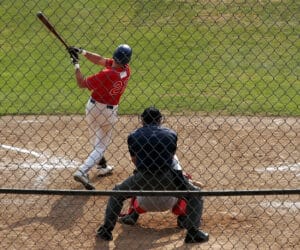
- Some umpires force the pitcher to earn their strikes, squeezing the zone. In doing so, they challenge the rule that any part of the ball crossing the zone counts as a strike. They may require at least half, or more, of the ball to be in the zone to call it a strike
- Some umpires expand the zone, forcing hitters to protect and swing at anything close. Little League emphasizes umpires incorporate this tendency, encouraging them to “think strikes” and make a ball convince them that it’s a ball. In more advanced leagues, umpires may lean this way to keep the game competitive or speed it up.
- In-game biases, like attitude and respect, can impact an umpire’s strike zone. If the pitcher is constantly talking back and arguing calls, the umpire may squeeze the zone (consciously or subconsciously) and make it harder for the pitcher to earn strike calls. On the flipside, a highly-esteemed veteran pitcher on top of their command may earn strike calls on borderline (or beyond borderline) pitches where other pitchers wouldn’t get that call.
The Human Element
All the various components that play a role in how an umpire determines the strike zone are based on the human element of the game. Umpires are human and they make mistakes.
Over the past 10 years, the MLB umpire’s average ball/strike call accuracy improved from 84% in 2016 to just over 88% in 2025 (according to Statcast data), leaving an average of 12% of all calls made inaccurately. That’s just one analysis. Another 2018 study concluded MLB umpires missed an average of 14 ball/strike calls per game between 2008 and 2018.
All of these analyses measure the performance of MLB umpires, the highest level of baseball officiating. It’s safe to say the human element plays an even greater role in lower levels, especially in youth leagues with volunteer umps.
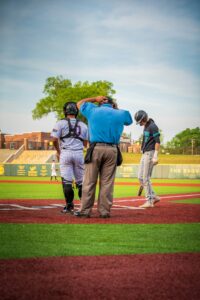
Source: Matt Benson on Unsplash
Impact of the Strike Zone on Gameplay
The baseball strike zone significantly impacts both pitching and hitting strategies in baseball. Players, coaches, and umpires rely on the strike zone to dictate the game.
The umpire’s ability to judge the strike zone is crucial. Umpires make errors throughout a game, due to their human judgment, which can impact gameplay.
As former MLB player and manager Davey Jones stated in 1999:
“It’s always been the job of the hitter and pitcher to recognize the strike zone on that particular night and adjust accordingly. We’ve had a published strike zone for like 200 years now and it’s always been at the discretion of each individual umpire.”
Coaches and players have to account for the umpire’s interpretation of the strike zone and its effect on the game.
How To Use The Strike Zone To Your Advantage
With preparation and detail, you can use the strike zone to your advantage as a:
- Hitter
- Pitcher, or
- Coach
As a hitter
The height of the strike zone changes based on the hitter’s stance.
As a batter, be aware of your stance and how that affects your strike zone. Remember the specific definition for your league and consider where the top and bottom boundaries exist in relation to your normal stance.
Adjust your hitting strategy based on the perceived size of the strike zone called by the umpire.
Every ump calls it differently and it’s important to take note of their tendencies. Pay attention to how the strike zone applies to your fellow teammates, as well as opposing hitters, and take note of anything that stands out. For example, some umpires give pitchers leeway on the outside corner while squeezing the inner portion of the plate.
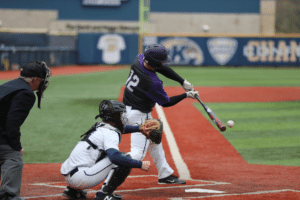
Don’t let the umpire making mistakes get to you.
While the umpire determines the outcome of a game in the sense that they call balls and strikes, you can’t let their human errors affect your mentality. If you show frustration or argue with an umpire, that may expand the strike zone when you’re at bat (intentionally or unintentionally).
Understand your “hot zones” and the pitcher’s tendencies.
As a hitter, you know the pitches you like best. These “hot zones” are the areas of the strike zone where you perform best. On the flipside, the pitcher works the strike zone based on their strengths as well as your “hot zones” and weaknesses. By understanding your strengths and how the pitcher works, you can capitalize on pitches they throw where you like them.
A sum of three zones.
Ted Williams, MLB legend and Hall of Famer, once made a quote that summarizes the strike zone’s role in relation to batters:
“The batter has three strike zones: his own, the opposing pitcher’s, and the umpire’s. The umpire’s zone is defined by the rule book, but it’s also more importantly defined by the way the umpire works. A good umpire is consistent so you can learn his strike zone. The batter has a strike zone in which he considers the pitch the right one to hit. The pitchers have zones where they are most effective. Once you know the pitcher and his zone you can get set for a particular pitch.”
As a pitcher
Target the edge of the strike zone to force difficult decisions from hitters.
The strike zone’s entire purpose is to keep batters from waiting for their ideal pitch and penalize them for letting quality, hittable pitches pass by. By pushing the boundaries and aiming to throw pitches at the edge of the zone, you can either freeze a batter into indecision or push them to swing at a ball that’s just outside the zone.
- The rules state that “any part of the ball” passing through the zone is a strike. Use that to your advantage as a pitcher, and aim for as little of the ball to be in the zone while still earning the strike call.
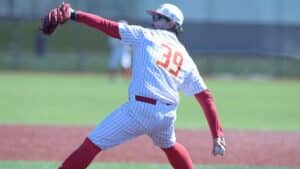
Consistently locate pitches within the strike zone to dominate batters more effectively.
A pitcher with command to all areas of the plate has an advantage over the batter. You know where the ball is going, and place it with confidence. The batter guesses what type of pitch is coming their way, and where. Umpires tend to reward pitchers that have control of the zone with more consistent strikes on “borderline” pitches. Earn their respect by locating pitches and displaying complete command.
Take note of how the umpire establishes the zone for you and your opponent.
If an umpire calls multiple borderline pitches on the outer edge of the plate a strike in the top of the first inning, use that knowledge when you go out in the bottom of the inning. Set and adjust your approach to the flow of the game and umpire tendencies you identify throughout.
Accept the umpire as a human element of the game.
As with hitters, pitchers cannot let discrepancies in an umpire’s judgement of the strike zone affect their performance. Umpires miss calls and pitchers need to accept that. If you display negative emotion or chirp at the ump in disagreement, there’s a chance the ump could hold that against you and shrink the zone.
- Even if you don’t show any emotion, you can’t let a bad call affect your approach. If you think a ball is a strike, there’s no sense dwelling on it. Treat it as if you threw a ball and continue attacking the hitter accordingly.
As a coach
Use the subjectivity of the zone to your advantage.
One of your responsibilities, as a coach, is to read the flow of the game and adjust accordingly. Understanding that the strike zone will be different with each umpire, and that it may change within the course of a game, equips you with knowledge for managing the game.
- Take note of an umpire’s tendencies and keep your team informed. If an umpire is squeezing the zone and not calling anything close on the outer edges, instruct your players to be patient at the plate. Encourage pitchers to attack the outside corner if the ump is giving it to them. There’s countless examples of this – too many to list – so always be analyzing the umpire’s zone and keeping your team in the loop.
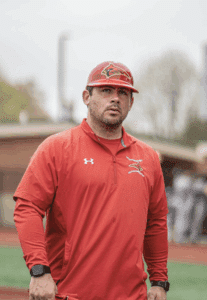
Ensure players understand umpires make mistakes and warn them of consequences from letting the umpire impact their mentality.
It’s the same for every player and coach on the field. The umpire is human and will inherently make mistakes throughout the game. A coach’s job involves removing the umpire from the equation in team messaging. Let players know that wrong calls are unavoidable and occur every game. Emphasize the potential consequences of letting that impact their mentality, including:
- Chirping with the umpire may lead to the zone shrinking (if it’s a pitcher arguing) or expanding (if a hitter argues). More importantly, players must respect the umpire as a human being. It’s important to teach young players respect as a life lesson that expands beyond the game.
- A missed call rarely affects the outcome of the game entirely. If a player loses focus over it, then the call snowballs into a self-inflicted, game-changing event.
Stand up for your players with inconsistent, fluctuating umpiring.
While you should set an example for players by respecting the umpire and not letting missed calls impact your mentality, it’s important for you to stand up for your players when egregious errors or inconsistency in the umpire’s judgement occur. You know the dimensions and technical rules of the strike zone. If an umpire is blatantly missing calls within the defined zone, or calling an inconsistent game that doesn’t establish any version of a subjective strike zone relative to the definition, you can talk to them. Don’t make a public scene or disrespect the umpire. Simply talk to them between innings to voice your concerns.
Keep players informed about changes in the strike zone throughout the game.
The zone changes by inning. Sometimes an umpire shrinks the zone late in a close game, forcing pitchers to beat the hitter. In these situations, it’s essential to gather your team and let them know. Incorporate any adjustments to the game plan or approach.
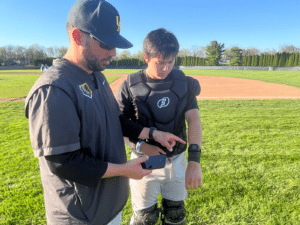
Use data to understand your strengths and weaknesses.
Pitching charts and detailed spray charts, along with other data, paints a picture of a particular player’s strengths and weaknesses within the strike zone. Baseball data analysis may show that a batter struggles on pitches up and in, but thrives anywhere on the outside edge of the plate. That can help you inform your game plan and instruct them on how to maximize strengths or address weaknesses.
Technology’s Role in Redefining the Strike Zone, Enhancing Umpire Performance, and Impacting Coaching Strategy
Umpires serve a pivotal role in baseball, as discussed previously, though the game has slowly infused more technology into final decision-making. The MLB introduced video replay in 2008, and its role expanded into different avenues of the sport.
Advanced technology created a precise automated tracking system to accurately determine whether a pitch is a ball or strike, which some call “robo umps” as full use of the system removes the human element from umpiring the strike zone. This prompted post-game reviews of umpire performance through sources like Umpire Scorecards and testing in lower levels of play.
That technology established the challenge system coming full-time to the 2026 MLB rules and season. Technology’s impacting the game for players, coaches, umpires, and fans through:
- Automated Ball-Strike (ABS) Challenge System
- Future ABS and Other Technological Expansion
- Non-Technical Umpiring Duties
- Tools for Baseball Coaches and Teams
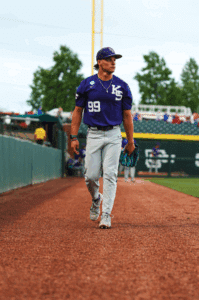
Automated Ball-Strike (ABS) Challenge System
The Automated Ball-Strike (ABS) challenge system incorporates technology in determining balls and strikes without removing the human element entirely. Initially designed by a Danish company to track ball movements for golf swings, the technology was repackaged for baseball application (specifically determining balls and strikes).
The system establishes an objective, mathematically determined strike zone based on each player’s height, using spring training measurements.
2026 MLB ABS Strike Zone Dimensions
The 2026 MLB ABS strike zone will measure:
| Boundary | Metric |
| Top | 53.5% of player’s height |
| Bottom | 24.2% of player’s height |
| Width | 17 inches |
With ABS, Hawk-Eye technology monitors the exact location of each pitch, relative to the batter’s zone. Through a private 5G network, the Hawk-Eye view is transmitted and sent to the stadium’s videoboard and public broadcast near instantaneously.
The independent Atlantic League spearheaded the inception of ABS in organized baseball during the 2019 campaign, with the system entering the MLB system in 2021 for testing at lower levels of MiLB. By 2025, it entered the big leagues with the MLB using ABS challenges during spring training and the All-Star game.
MLB ABS Challenge System Rules
2026 marks the first full season of MLB play with the ABS challenge system. Each team starts the game with two challenges to use at any time.
A challenge must be called:
- Only by the batter, pitcher, or catcher (managers and coaches cannot call for a challenge), and
- Immediately without assistance from the dugout or other players
The player taps their cap or helmet to alert the ump of their desire to challenge the call. Teams retain all successful challenges, only losing them if the system confirms the umpire’s call.
Because teams can lose challenges, players must be judicious about when to use them. In general, it’s wise to save challenges for high-leverage situations instead of risking them in moments that aren’t as impactful. For this reason, the league and supporters argue that ABS adds strategy to the game and serves as a middle ground between “robot umps” and human officials.
Future ABS and Other Technological Expansion
Though it’s in play for challenges, the ABS system doesn’t garner overwhelming support as the one “true source” for calling balls and strikes in baseball. “The strong preference from players for the Challenge format over using the technology to call every pitch was a key factor in determining the system” the MLB announced in September 2025.
Outside of MLB players, there are several points of contention or hesitation for implementing full “robo ump” ABS rules:
- MiLB testing revealed clear preference among fans, players, managers, and other personnel for the challenge system only. Fans and baseball participants still want the human element of umpiring that accounts for the feel of the game.
- Incorporating full use of the ABS could negatively impact pace of play. Walks were more prevalent in ABS MiLB games, causing the game to go longer and counteracting the pitch clock’s efforts to speed up pace of play.
- Pitch framing would become a lost art. With full ABS, catcher pitch framing would go away. It’s a craft that catchers study and master, and baseball purists credit as essential to the game’s integrity.
Regardless of the current attitude, full ABS integration into MLB games is a possibility. They’ve previously tested it in levels of MiLB and other major professional sports leagues. Tennis, most notably, replaced official decisions for line-calling with Hawk-Eye technology at major events like the U.S. Open and Wimbledon.
At the current rate, the general consensus amongst players, coaches, executives, and fans is not in favor of “robo ump” full-scale ABS use. Technology is rapidly evolving and, with it, opportunities to expand the definition and enforcement of the strike zone
Non-Technical Umpiring Duties
The human element of umpiring and officiating remains, even if full-time ABS use was incorporated. Umpires are human and understand the nuances of the game technology can’t account for.
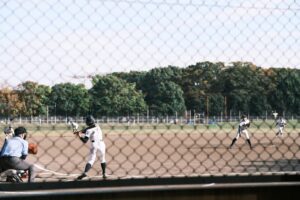
Source: Capture @Moments on Unsplash
Umpires oversee the pace of the game and handle disputes. They manage the emotions of players and coaches, keeping the game respectful and ethically competitive. No matter the technological advances, umpires bring judgement, experience, and the ability to handle a complex, unforeseen future in baseball.
Strike Zone Technology for Baseball Coaches and Teams
At all levels, strike zone technology can aid coaches and teams in strategy and execution. With readily available advanced baseball analytics tools and data at the hands of professional, college, high school, and youth levels, coaches can analyze the strike zone for offensive and defensive insights like never before.
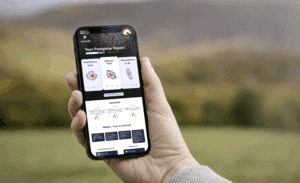
Pitch calling technology like GoRout Diamond and advanced charting apps like AWRE Sports provide professional-level strike zone analytics including:
- Strike Zone Maps (Attack Zones & Heat Maps)
- Spray Charts
- Pitch Intent vs. Pitch Result Analysis
Strike Zone Maps (Attack Zones & Heat Maps)
Strike zone maps provide coaches with visual representations of offensive and defensive data.
- Attack zones are visual displays of the percentage each corner of the strike zone is hit, with exact, charted locations of each pitch filtered by pitch type.
- Heat maps paint a visual picture of where pitchers are attaching hitters, where they’re most effective, and what they need to work on.
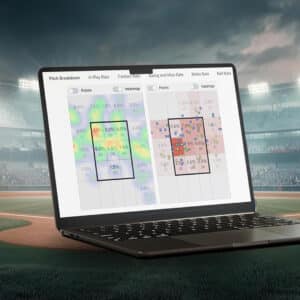
Spray Charts
Modern baseball spray chart technology goes beyond tracking what part of the field batters put the ball in play. Spray charts provide strike zone visuals to give coaches a better understanding of:
- Which types of pitches and locations are being hit
- Which areas of the strike zone are players “hot” or “cold” zones
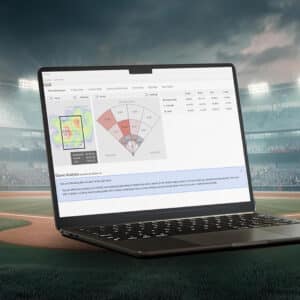
Pitch Intent vs. Pitch Result Analysis
Using automated charting, the technology compiles game information and provides analysis of pitch intent versus results. It accounts for the pitches a coach calls and uses the chart’s tracking data to assess how accurate the actual pitch was compared to the desired call.
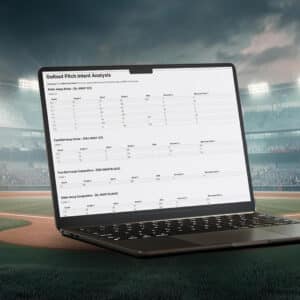
Command The Strike Zone With GoRout Connect
Technology dictates baseball at all levels with the pitch calling device. GoRout, a proven and trusted trailblazer in electronic pitch calling systems, provides coaches professional level tools with the introduction of GoRout Connect.
GoRout’s newest operating system takes coaches and players inside the strike zone after every game. Its seamless integration with third-party platforms incorporates a robust suite of analytics and reports to enhance the coaching experience and overall efficiency.
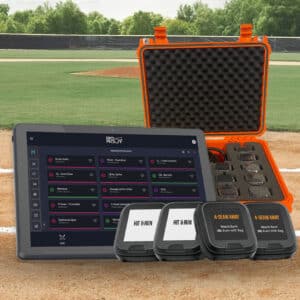
ABS systems may not be applicable to youth leagues, travel baseball, high school programs, and other lower levels of play, but there are tools available that take you inside the strike zone through advanced technology.
If you’re interested in professional-grade strike zone analytics for your team, baked into an innovative baseball pitch calling system, get a quote from GoRout today.

Baseball Strike Zone FAQs
What is the official baseball strike zone?
The official baseball strike zone is the area above home plate that dictates whether a pitch is a strike, and where the pitcher aims to throw the ball.
Official definitions of the strike zone varies by league, spearheaded by these four major organizations:
| League | Definition |
| Little League (Youth) | The space over home plate which is between the batter’s armpits and the top of the knees when the batter assumes a natural stance. |
| NFHS (High School) | The space over home plate; the top of which is halfway between the batter’s shoulders and the waistline, and the bottom being the knee. |
| NCAA (College) | The area over home plate from the bottom of the kneecaps to the midpoint between the top of the shoulders and the top of the uniform pants. |
| MLB (Professional) | The area over home plate from the midpoint between a batter’s shoulders and the top of the uniform pants and a point just below the kneecap. |
Does the strike zone change with height?
The strike zone does change with height, with the top and bottom varying by each batter’s individual body makeup, height, measurements, and stance. Most major organization’s definition sets the height of the strike zone as “determined by the batter’s normal stance” or similar terminology.
In general, a taller player has a larger strike zone. However, a tall player that crouches more in their natural stance could share the same strike zone as a shorter player who stands straight in their natural stance.
How has the MLB strike zone changed?
The MLB strike zone transformed over time, from before the league was officially created. From early professional leagues letting batters determine the zone to incorporating electronic strike zone technology, MLB’s strike zone has changed many times throughout its existence.
Here is a brief timeline on the history of MLB strike zone definitions:
Year |
Changes or Updates |
1858 |
The strike zone was established after the conception of the “called strike” at the First Base Ball Convention |
1871 |
The National Association of Professional Base-Ball Clubs, the very first professional baseball league to exist, gave batters the power to determine where the pitcher would throw the ball.
|
1876 |
The National League of Baseball Clubs, which would grow into Major League Baseball, formed as a professional organization and set three distinct “zones” for batters to call:
|
1887 |
The first official strike zone designation occurred at the 1886 winter meetings, while setting official rules for the 18878 season in the National League of Baseball Clubs and the American Association of Baseball Clubs.
|
1907 |
The MLB changes its strike zone with new designations of fairly delivered balls instead of strikes, and unfairly delivered balls in place of balls. |
1950 |
MLB redefines the strike zone as “the space over home plate which is between the batter’s armpits and the top of his knees when he assumes his natural stance.” |
1963 |
MLB expands the strike zone in response to Roger Maris breaking Babe Ruth’s single-season home run record, among a string of other impressive offensive seasons league-wide. |
1969 |
MLB retracts and shrinks the strike zone closer to the 1950 definition in response to a, referred to as “Year of the Pitcher”, where pitchers were dominant. |
1988 |
MLB updates the strike zone, creating a new definition for the top boundary as “a horizontal line at the midpoint between the top of the shoulders and the top of the uniform pants.” |
1996 |
MLB lowers the bottom boundary of the strike zone, creating the official definition that remains today:
|
2025 |
MLB tests the Automated Ball-Strike (ABS) Challenge system in Spring Training and the All-Star Game. |
2026 |
MLB incorporates Automated Ball-Strike (ABS) Challenge system full-time to all games.
The “definition” of the ABS zone is:
|
What are the dimensions of an MLB strike zone?
The official dimensions of the MLB strike zone are from the midpoint between a batter’s shoulders and the top of the uniform pants, and 17 inches wide (the standard width of home plate).
In 2026, the MLB Automated Ball-Strike (ABS) Challenge system’s technical strike zone dimensions will be:
- Top: 53.5% of player’s height
- Bottom: 24.2% of player’s height
- Width: 17 inches
How do umpires know the strike zone?
The umpires know the strike zone because each league defines the dimensions in its rules and regulations. The strike zone varies by league, but each umpire knows the definition for their respective assignments.
The umpire’s interpretation of the definition and perception of the zone vary by person. Even though there’s a standardized strike zone, the definitions leave room for interpretation and subjectivity.
Why doesn’t baseball use an electronic strike zone?
Baseball leagues of all levels avoid using an electronic strike zone to maintain a human element of umpiring that accounts for the feel of the game. Professional leagues have tested variations of an electronic strike zone, but the general sentiment remained in favor of using technology paired with human judgment through a challenge system. The MLB plans to add a full-time Automated Ball-Strike (ABS) challenge system into the 2026 rules.
Additionally, many lower levels of baseball don’t have the budget or resources to incorporate a league-wide electronic strike zone. If not all teams or fields have the access or capability to roll out electronic strike zone technology, the league cannot incorporate it into the rules or make it standard.
Do baseball and softball use the same strike zone?
No, baseball and softball do not use the same strike zone. Each zone is defined by the governing body of the respective league.

